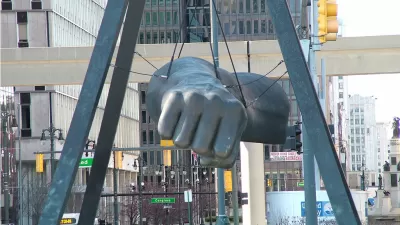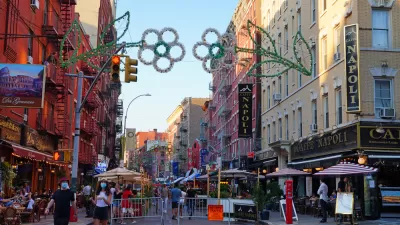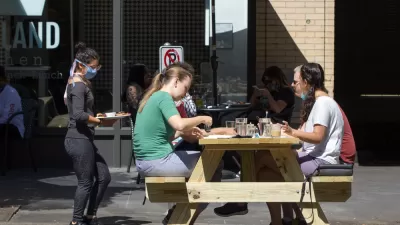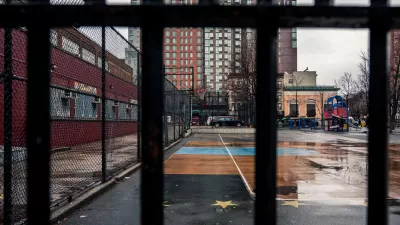A New York Times editorial presents a resoundingly pro-urban call to action regarding the future of planning and investment.

The Editorial Board of the New York Times published a feature-length defense of cities that also serves as a call to action for policy makers: break down class divides to rebuild urban areas in the wake of the coronavirus.
"The cities we need," the title of the editorial, builds its case on the history of cities as the "hammering engines of the nation’s economic progress, the showcases of its wealth and culture, the objects of global fascination, admiration and aspiration."
That was before, according to the editorial—long before the coronavirus upended life in the United States. For decades the infrastructure that built the economic prowess of U.S. cities has crumbled, and class divides have grown. The pandemic threatens to exacerbate the negative effects of these trends, according to the editorial.
The pandemic has prompted some affluent Americans to wonder whether cities are broken for them, too. It has suspended the charms of urban life while accentuating the risks, reviving an hoary American tradition of regarding cities with fear and loathing — as cesspools of disease, an image that all too easily aligns with prejudices about poverty and race and crime. Even New York’s governor, Andrew Cuomo, has described New York City’s density as responsible for its suffering.
Here enters the central claim of the editorial: the compulsion to flee the city and to abandon the urban cause is "dangerously misguided." The best hope for the nation, as expressed here, is to break down the inequalities of the city, and to "change the harsh reality that the neighborhoods into which Americans are born delimit their prospects in life…"
The editorial's recommendations for achieving those lofty goals will prove controversial in every kind of community, such as reducing segregation by reversing the planning policies that exclude affordable housing development in affluent neighborhoods and by equitable investments in urban public schools.
This reader can't recall an editorial of such scope and ambition, including interactive features and requiring long-read patience of the audience. Similarly, this reader cannot recall such strict adherence to pro-urban polemics, even when delivered at the expense of suburban communities. A passage that describes a suburban community outside of Cincinnati as a parasite promises to inspire numerous counter arguments:
Life in America resembles an airline passenger cabin: separate entrances, separate seating areas, separate bathrooms. The Village of Indian Hill, a wealthy suburb of Cincinnati, touts its rural atmosphere, its “firm administration of zoning ordinances” and its “proximity to the cultural life of a large city.” It is, in short, a parasite, taking what it values from Cincinnati while contributing as little to it as possible. In this, it is hardly unique. Hundreds of similar suburbs encrust cities across the United States.
For more on the future direction of urban planning and cities in the post-Covid future, see previous Planetizen coverage gathered under the "Coronavirus and Density" tag.
FULL STORY: The Cities We Need

Maui's Vacation Rental Debate Turns Ugly
Verbal attacks, misinformation campaigns and fistfights plague a high-stakes debate to convert thousands of vacation rentals into long-term housing.

Planetizen Federal Action Tracker
A weekly monitor of how Trump’s orders and actions are impacting planners and planning in America.

In Urban Planning, AI Prompting Could be the New Design Thinking
Creativity has long been key to great urban design. What if we see AI as our new creative partner?

King County Supportive Housing Program Offers Hope for Unhoused Residents
The county is taking a ‘Housing First’ approach that prioritizes getting people into housing, then offering wraparound supportive services.

Researchers Use AI to Get Clearer Picture of US Housing
Analysts are using artificial intelligence to supercharge their research by allowing them to comb through data faster. Though these AI tools can be error prone, they save time and housing researchers are optimistic about the future.

Making Shared Micromobility More Inclusive
Cities and shared mobility system operators can do more to include people with disabilities in planning and operations, per a new report.
Urban Design for Planners 1: Software Tools
This six-course series explores essential urban design concepts using open source software and equips planners with the tools they need to participate fully in the urban design process.
Planning for Universal Design
Learn the tools for implementing Universal Design in planning regulations.
planning NEXT
Appalachian Highlands Housing Partners
Mpact (founded as Rail~Volution)
City of Camden Redevelopment Agency
City of Astoria
City of Portland
City of Laramie





























